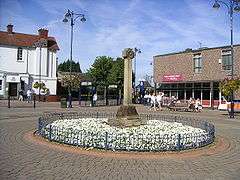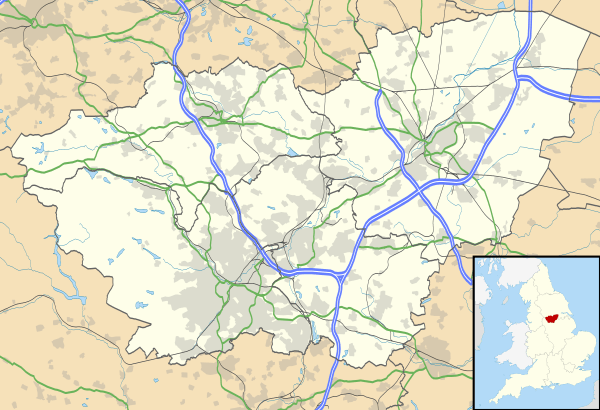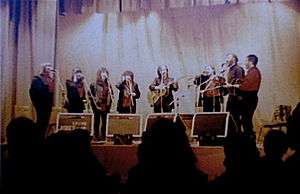Wath upon Dearne
Wath upon Dearne (often hyphenated or abbreviated to Wath /ˈwɒθ/) is a town on the south side of the Dearne Valley in the historic county of the West Riding of Yorkshire and the Metropolitan Borough of Rotherham, South Yorkshire, England, 5 miles (8 km) north of Rotherham and almost midway between Barnsley and Doncaster. It had a population of 11,816 at the 2011 census.[1] It is twinned with Saint-Jean-de-Bournay, in France.[2]
| Wath upon Dearne | |
|---|---|
 The Market Cross, Montgomery Square, Wath-upon-Dearne | |
 Wath upon Dearne Location within South Yorkshire | |
| Population | 11,816 (2011 census)[1] |
| OS grid reference | SE438008 |
| Metropolitan borough | |
| Metropolitan county | |
| Region | |
| Country | England |
| Sovereign state | United Kingdom |
| Post town | ROTHERHAM |
| Postcode district | S63 |
| Dialling code | 01709 |
| Police | South Yorkshire |
| Fire | South Yorkshire |
| Ambulance | Yorkshire |
| UK Parliament | |
History
Wath can be traced back to Norman times, It has an entry in the 1076 Domesday Book as Wad and Waith. It remained for some centuries a rural settlement astride the junction of the old Doncaster–Barnsley and Rotherham–Pontefract roads, the latter a branch of Ryknield Street. North of the town was the ford of the River Dearne. The origin of its name has been linked to the Latin vadum[3] and the Old Norse vath (ford or wading place).[4] The town received a Royal Charter in 1312–1313. entitling it to a weekly Tuesday market and an annual two-day fair, but these were soon discontinued. The market was revived in 1814.[5]
Until the mid-19th century the town had a racecourse of regional importance, linked to the estate at nearby Wentworth. This fell into disuse, but traces of the track can be seen between Wath and Swinton and it is remembered in street names.[6] There was a pottery at Newhill, close to deposits of clay, but it was overshadowed by the nearby Rockingham Pottery in Swinton.[3] About the turn of the 19th century, the poet and newspaper editor James Montgomery, resident at that time, called it "the Queen of villages". This rural character changed rapidly in the 19th and 20th centuries, as coal mining developed.[7]
Coal mining
The town lies within the South Yorkshire coalfield, where high-quality bituminous coal was dug from outcrops and near-surface seams in primitive bell pits for many hundreds of years. Several high-grade coal seams are close to the surface in this area, including the prolific Barnsley and Parkgate seams. The rising demand for coal arose from rapid industrialisation of the area in the 19th and early 20th century.[7] The population swelled and the local infrastructure was developed for the coal industry, but this reliance on the one industry stored up future problems.
The Dearne and Dove Canal, opened in stages from 1798 to 1804 to access the collieries on the southern side of the Dearne Valley, passed through the town just north of the High Street on an embankment and then turned north into the valley. This wide section was known locally as the "Bay of Biscay". The canal closed in 1961 after many years of disuse and poor repair.[8] Much of the canal line has since been used for roads, one of them called Biscay Way.[7]
By the 20th century, heavy industry was evident, with many large collieries operating. Wath Main and Manvers Main were the two usually mentioned. After the Second World War, the collieries clustered around Manvers were developed into a large complex, also covering coal preparation, coal products and a coking plant, which was not only visible, but detectable in the air for miles around.
Railways
Rail took over from the canal as a means of coal transportation. Wath upon Dearne became a rail-freight centre of national importance. Wath marshalling yard, built north of the town in 1907, was one of the biggest, and for its time most modern railway marshalling yards in the country. It was one of the eastern ends of the trans-Pennine Manchester–Sheffield–Wath electrified railway (also known as the Woodhead Line), a project which spanned the Second World War and was in part justified by the need to transport large amounts of coal mined in the Wath area to customers in North-West England.
Wath once had three railway stations: Wath Central in Moor Road, Wath (Hull and Barnsley) and Wath North both in Station Road, in order of distance from the town centre. This most distant station was the last to close in 1968, under the Beeching Axe. The town no longer has a rail link, although there has been talk of opening a station on the Sheffield–Wakefield–Leeds line at Manvers, roughly a mile from the town centre.
The decline of coal
The local coal industry was in the forefront of the dramatic decline of the British coal-mining industry, precipitated by a change in government economic policy in the early 1980s. This had severe knock-on effects on many subsidiary local industries and caused much local hardship. The 1985 miners' strike was sparked by the impending closure of Cortonwood Colliery in Brampton Bierlow, a neighbouring village often considered part of Wath. Along with the whole of the Dearne Valley, Wath was classified as an impoverished area and received much public money, including European funds. These were put into regenerating the area from the mid-1990s onwards, causing a certain amount of economic revival, and made the area to be more rural, as much land to the north of the town once used by collieries and marshalling yards was returned to scrubland and countryside, dotted with light industrial and commercial office parks. This regeneration of what was still classified as brownfield land has involved building it over with various industrial and commercial parks, and large housing developments have also been started.
Today

Wath upon Dearne is centred on Montgomery Square, which contains the town's main shops, the library and the bus station. Immediately to the west is the substantial Norman All Saints Church,[9] on a small leafy green with the Town Hall, the Montgomery Hall and a campus of the Dearne Valley College. There are several pubs in the town centre, including a branch of Wetherspoons and Wath Tap, Rotherham's first micro-pub specialising in locally brewed real ale.
Today Wath is still emerging from the sudden collapse of the coal industry, although jobs and some low-level affluence have returned. After a hiatus between the clearing of the former colliery land and recent redevelopment, when the area felt rather rural, the construction of large distribution centres to the north of the town is restoring an industrial feel, but without the pollution issues connected with coal. Recently several large distribution warehouses for the clothing chain Next have opened. Much new housing is being built on this reclaimed land.
Wath Festival, held around the early May bank holiday, is a folk and acoustic music and arts festival founded by members of the Wath Morris Dancing Team in 1972. It has grown to host some well-known names on the folk, acoustic and world music scene. While festival events occur across the town, most of the larger music concerts are held at the Montgomery Hall Theatre and Community Venue. Artists recently appearing include Dougie MacLean, Fairport Convention, Martin Simpson, John Tams, Frances Black, John McCusker, Stacey Earle and Eddi Reader.
The festival celebrated its 40th anniversary in 2012 and won Village Festival Of The Year in the 2013 FATEA Awards.[10] The festival has been a supporter of upcoming young artists such as Lucy Ward, and Greg Russell & Ciaran Algar. It has also hosted the Wath Festival Young Performers Award, founded by the young Sheffield-based musician Charlie Barker in 2011, who handed it over to a festival committee in 2014. Winners of the Young Performers Award include Luke Hirst & Sarah Smout, Sunjay, Rose Redd and Hannah Cumming.
The event includes traditional dancing from local Morris and Sword Dancing groups, street performances, workshops, children's events, and a Saturday morning parade from Montgomery Hall through Montgomery Square and back to St James's Church, for a traditional throwing of bread buns from the parish church tower. Local schools, organisations and local Labour MP John Healey are active in celebrating the town's history and contributing to community activities at the annual festival.
The RSPB's Old Moor nature reserve lies a mile to the north-west of the town.[11] It occupies a "flash", where mining-induced subsidence of land close to a river has created wetlands.
Sport
Wath Athletic F.C. served the community from the 1880s to the Second World War, playing in the Midland League and reaching the 1st Round of the FA Cup in 1926. No senior team has represented the settlement since the 1950s, and Wath remains one of the largest areas in Yorkshire without such a team. However, it has a Rugby Union team that plays in the Yorkshire Division 2.
Education
There are four primary schools, all serving ages 3–11: Our Lady and St Joseph's Catholic Primary School, Wath Central Primary School, Wath C of E Primary School, and Wath Victoria Primary School. The town's two secondary schools are Saint Pius X Catholic High School (an 11–16 school) and the much larger Wath Academy, which has a sixth form and provides 11–18 education. Both take students from a wider area. Wath (Park Road) Secondary Modern School closed in 1963.
A large further education college, Dearne Valley College, based in Wath, has a main campus at Manvers and a smaller one near the town centre.
Notable people
- Anthony Arkwright, spree killer, was convicted in 1989 of murdering three people in 1988.[12]
- David Bret, show-business biographer, born in Paris, was adopted into a family (Spurr) here, and attended Wath Grammar School in 1961–1966.
- Lucy Clarkson, Lara Croft Tomb Raider model, was born in Rotherham and educated at Wath Comprehensive School.
- Rob Dawber was scriptwriter for the Ken Loach film, The Navigators.
- Simon Farnaby, actor, plays characters in the CBBC TV show Horrible Histories.
- William Hague, Baron Hague of Richmond, former leader of the Conservative Party and cabinet minister, was a pupil at Wath Comprehensive School.
- Peter Hardy, Baron Hardy of Wath, local Labour MP for many years, was born and educated in Wath.
- Rev. William Keble Martin, botanist and botanical illustrator and vicar of Wath, is remembered in a street name, Keble Martin Way.
- Ian McMillan, poet and so-called Bard of Barnsley, was educated at the town's secondary school when it was a Grammar School.
- James Montgomery, Scottish-born poet and Sheffield newspaper editor, lived in Wath at the turn of the 19th century. He is remembered in the names of Montgomery Hall and Montgomery Square.[7]
- Sir Charles Curran, Director-General of the BBC, 1969–1977, was educated in Wath.
- Jorge (George) Robledo, professional footballer, lived in a house later occupied by David Bret and his adoptive parents. The Chilean National played for Huddersfield, Barnsley and Newcastle United and scored the winning goal for Newcastle in the 1952 FA cup final against Arsenal. He was the first non-Irish foreign national to be a League top scorer.
- Eduardo (Ted) Robledo, brother of George, also played professionally for Huddersfield, Barnsley and Newcastle United.
References
- UK Census (2011). "Local Area Report – Wath Ward (as of 2011) (1237320697)". Nomis. Office for National Statistics. Retrieved 13 October 2018.
- UK Twin Towns Archived 24 June 2007 at the Wayback Machine
- W. Keble Martin, A History of the Ancient Parish of Wath-upon-Dearne (South Yorkshire), W. E. Farthing, 1920.
- F. W. Moorman, West Riding Place Names (Leeds: privately printed for Thoresby Society), 1910.
- David Hey, Medieval South Yorkshire (Ashbourne:Landmark Publishing) 2003 ISBN 978-1-84306-080-2
- geograph.org.uk page on Racecourse Road on the Wath/Swinton border, built on the line of the course.
- "Wath-upon-Dearne the 'Queen of villages'".
- Roger Glister, The Forgotten Canals of Yorkshire: Wakefield to Swinton via Barnsley; The Barnsley and Dearne & Dove Canals (Barnsley:Wharncliffe Books) 2004 ISBN 1-903425-38-7
- "All Saints Parish Church, Wath upon Dearne". wathparishchurch.co.uk. Retrieved 10 March 2020.
- "FATEA – Fatea Awards Nominations 2013". www.fatea-records.co.uk. Retrieved 9 May 2019.
- RSPB Old Moor
- "The sick killer who lived up to his Ripper boasts". The Yorkshire Post. 18 June 2002. Retrieved 14 April 2018.